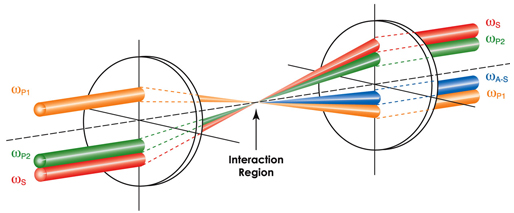|
Dual-Pump Coherent Anti-Stokes Raman Spectroscopy
(DP-CARS)
The DP-CARS technique is a nonlinear optical technique in which three laser beams cross, focus and interact with a gas flow to generate a fourth laser beam which is analyzed to determine the temperature and composition of a flowfield at the crossing point. An important feature of this method is that all the interacting beams are, in fact, spatially coherent laser beams, so the technique can be used to make remote measurements in conditions where there is limited optical access, for example in ducts through thin, slotted windows, such as scramjet engines.

In our current use, the three input beams are yellow, green and red. The red beam is spectrally broadband while the yellow and green are spectrally narrow. The combination of the yellow and red beams probe O2 Raman resonances, while the combination of green and red beams probe N2 Raman resonances. Both pairs of beams also probe H2 resonances and all three beams are required to complete the CARS process. The spectrally broad blue beam then contains information about the concentration of N2, O2 and H2 as well as the temperature (from the shape of these spectra).

The figure above shows how DP-CARS mapped the temperature and composition fields in a supersonic combustor. Flow is from top left to bottom right. Hot air enters the duct at the top left, cold H2 fuel is injected from the top wall and then burns as the flow propagates downstream, elevating the temperature. These data have been used by several research groups around to world to test and improve their computational methods.
|




